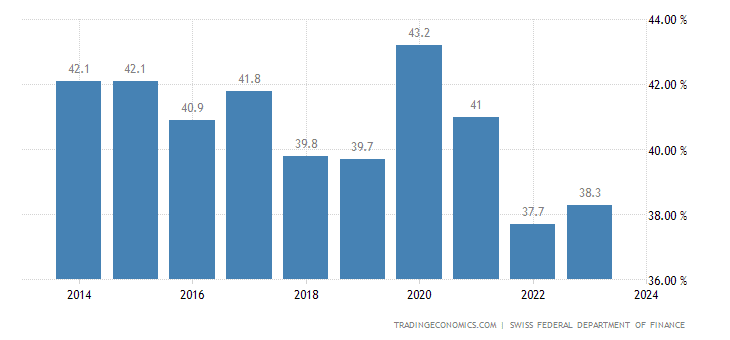oldfart
Older than dirt
After five years of Sturm und Drang over the deficit, maybe it's time to discuss thereal problem, which is certainly not the deficit. CBO has an interesting study out which tie in nicely.
First, the goal is not a zero deficit. The commonly accepted goal by fiscal experts and economists is a deficit which causes the national debt to increase at the same rate as GDP or less. In other words, the ratio of national debt to GDP would remain the same or decrease. So what is this number?
Given a publicly held debt of $11.5 trillion (the $16 trillion bandied about includes inter-agency debt and shouldn't be counted in debt unless we are also going to count all the government assets; what an aircraft carrier worth? oil reserves on public land? the Eisenhower Interstate Highway System? If we are going to do a balance sheet and declare the government insolvent, where's the listing of assets? I digress.) Assuming a conservative nominal growth rate of GDP of 4% (2% real growth, 2% inflation) this works out to $450 billion or so of sustainable deficit.
OK, deficits grow when the economy is in the tank. Tax revenues fall faster than income when we have a progressive income tax system, and expenses such as unemployment benefits, disability retirees, and other "automatic stabilizers" increase. Without the countercyclical nature of these automatic stablilizers, today the economy would have about 40% unemployment and GDP would be 25% lower. Put another way, if we had "real austerity" we would be in the 30's again. Put a third way, every effort at balancing the budget in a major downturn inevitably drives the economy toward disaster of Dickensian proportions.
So what would the deficit be if we were not in an anemic recovery? What if the economic stabilizers were at the normal near-full-employment levels? The recent CBO study calculates that in fiscal 2013 these stabilizers will amount to $422 billion, accounting for just about half of a projected $845 billion deficit. So the cyclically adjusted deficit will be $423 billion.
CBO | The Effects of Automatic Stabilizers on the Federal Budget as of 2013
So if the cyclically adjusted deficit for 2013 will be $423 billion and the sustainable deficit is $450 billion, if we do nothing EXCEPT rapidly return the economy to normal levels of employment. the share of debt to GDP will DECREASE slightly. And how do we return the economy to health? STIMULUS.
The only economically viable program is to ditch austerity and deficit reduction, which prolong the Great Recession indefinitely and use stimulus to return the economy to economic health. This is what sensible economists have prescribed for similar although less severe situations for the last fifty years with success, and what they have been advocating for the last five years. It's the politicians and ideologues who are tone deaf.
First, the goal is not a zero deficit. The commonly accepted goal by fiscal experts and economists is a deficit which causes the national debt to increase at the same rate as GDP or less. In other words, the ratio of national debt to GDP would remain the same or decrease. So what is this number?
Given a publicly held debt of $11.5 trillion (the $16 trillion bandied about includes inter-agency debt and shouldn't be counted in debt unless we are also going to count all the government assets; what an aircraft carrier worth? oil reserves on public land? the Eisenhower Interstate Highway System? If we are going to do a balance sheet and declare the government insolvent, where's the listing of assets? I digress.) Assuming a conservative nominal growth rate of GDP of 4% (2% real growth, 2% inflation) this works out to $450 billion or so of sustainable deficit.
OK, deficits grow when the economy is in the tank. Tax revenues fall faster than income when we have a progressive income tax system, and expenses such as unemployment benefits, disability retirees, and other "automatic stabilizers" increase. Without the countercyclical nature of these automatic stablilizers, today the economy would have about 40% unemployment and GDP would be 25% lower. Put another way, if we had "real austerity" we would be in the 30's again. Put a third way, every effort at balancing the budget in a major downturn inevitably drives the economy toward disaster of Dickensian proportions.
So what would the deficit be if we were not in an anemic recovery? What if the economic stabilizers were at the normal near-full-employment levels? The recent CBO study calculates that in fiscal 2013 these stabilizers will amount to $422 billion, accounting for just about half of a projected $845 billion deficit. So the cyclically adjusted deficit will be $423 billion.
CBO | The Effects of Automatic Stabilizers on the Federal Budget as of 2013
So if the cyclically adjusted deficit for 2013 will be $423 billion and the sustainable deficit is $450 billion, if we do nothing EXCEPT rapidly return the economy to normal levels of employment. the share of debt to GDP will DECREASE slightly. And how do we return the economy to health? STIMULUS.
The only economically viable program is to ditch austerity and deficit reduction, which prolong the Great Recession indefinitely and use stimulus to return the economy to economic health. This is what sensible economists have prescribed for similar although less severe situations for the last fifty years with success, and what they have been advocating for the last five years. It's the politicians and ideologues who are tone deaf.

